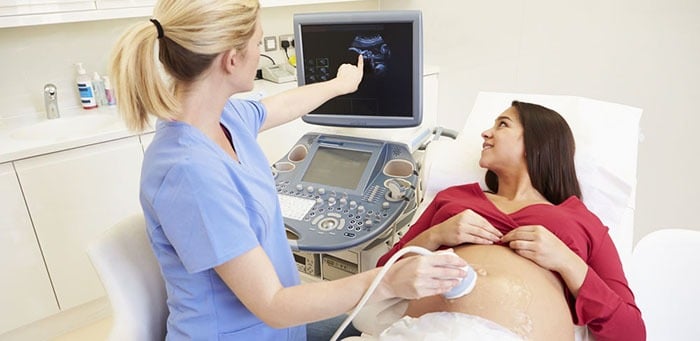Private Scan for Ectopic Pregnancy
Ultrasound imaging is the first line of tests performed when ectopic pregnancy is suspected.
An ectopic pregnancy happens when the products of fertilization implant and develops beyond the confines of the uterus, and it is one of the more serious complications of pregnancy.
It is one of the most common reasons for an early pregnancy scan as the incidence of ectopic pregnancies is 1-2% and is still the most common cause of pregnancy-related death in the first trimester, accounting for about 10% of all pregnancy-related deaths.
Another common reason for pregnancy scans in the first trimester is miscarriage.
Ectopic pregnancy is almost always not viable, except for very few instances. This condition can bring bleeding within the abdominal cavity which can be fatal for the mother. The most common form of ectopic pregnancy is one that takes places within the fallopian tubes, which is also called a tubal pregnancy. Other locations of implantation are the ovaries, cervix, and the abdomen. As has been mentioned, this condition can bring bleeding and death, and as such should be treated as an emergency.
The course of a normal uterine pregnancy starts when the uterus receives the newly fertilized egg. The egg implants itself in the nutrient-rich uterine lining where it will eventually develop. On the other hand, in ectopic pregnancy, this process does not take place in the uterus: 98% of the time it happens in the Fallopian tubes.
Diagnosis of Ectopic Pregnancy
With the current advances in diagnostic tools and procedures such as the early pregnancy scan, ectopic pregnancy can be detected and addressed earlier.
However, in spite of the diagnostic advances, this condition is still the main cause of morbidity and mortality among mothers all over the world. An increase in the incidence of ectopic pregnancy can be found in countries with substandard prenatal imaging and care.
International Ultrasound Services offers same-day early pregnancy scans as well as other private pregnancy scans in an effort to speed up diagnosis and treatment.
If you suspect that you might have an ectopic pregnancy you should seek medical assistance immediately.
Ectopic pregnancy takes place when the fertilized egg implants into the lining of the Fallopian tube. The egg eventually erodes into the surrounding blood vessels, bringing about bleeding. The bleeding that takes places within the Fallopian tube will push the egg out of the tube, ending up in what is called a tubal abortion. The Fallopian tube does not undergo inflammation in this case, and the pain is brought about by the prostaglandins present at the actual area of implantation and the irritation due to the presence of blood in the peritoneum.
When bleeding becomes more profuse, it can bring about the threat to the mother. While the common cause of the increase in bleeding is the delay in the diagnosis of ectopic pregnancy, some bleeding takes place a little faster. This is especially true when the implantation takes place in the proximal area of the Fallopian tube. In this case, the egg may eventually erode into the Sampson artery located in proximity to the tube.
In 50% of cases, ectopic pregnancies resolve by itself, without intervention. This is especially true with tubal abortions. Currently, the need to perform the surgery has been drastically reduced with the introduction of methotrexate in the treatment of ectopic pregnancy. It should be remembered, though, that surgery will still have to be performed when the Fallopian tubes is near rupture or have already ruptured. Surgery may entail a limited incision via a laparoscopic method, or a larger incision may be used, in which case it is called a laparotomy.
Ectopic Pregnancy Signs and Symptoms
The early signs and symptoms of ectopic pregnancy are usually so subtle, if they are even present, which is why it is quite difficult to make an early diagnosis. The average time for the signs and symptoms of ectopic pregnancy to present themselves is about 7.2 weeks following the last menstruation, and the range is from 5 to 8 weeks. Diagnosis may come in even later for areas where facilities are insufficient.
The following are the early presentations of ectopic pregnancy:
Hypogastric pain accompanied by a sensation of swelling. The pain may be perceived as intense stomach pain, but the pain may also occur in the form of a strong cramping sensation.
Dysuria, or pain when urinating
A vague abdominal discomfort which is similar to symptoms brought about by the presence of corpus luteum in the ovary
Mild vaginal bleeding. This is a form of withdrawal bleeding, a phenomenon that occurs when progesterone levels go down. This symptom may also be noted during the early stage of pregnancy (also called “ implantation bleed”) or during a miscarriage.
Abdominal pain during a bowel movement.
Later on, ectopic pregnancy presents itself as pain and bleeding, which may be vaginal or abdominal, or both. The causes of bleeding are as follows:
Hormonal trigger, i.e., a drop in the level of progesterone
• Peritoneal bleeding secondary to rupture of the Fallopian tube
Differential diagnosis includes miscarriage and normal pregnancy in its early stage. Pelvic inflammatory disease, or PID, is the most common faulty diagnosis for ectopic pregnancy. To rule out the presence of PID, a pregnancy test can be performed. A positive pregnancy test essentially rules out PID because a pregnancy that is concurrent with an active pelvic infection is very rare.
When bleeding becomes more profuse, the following symptoms may occur:
• Pain which may be located at the lower back, abdomen, and pelvis
• Shoulder pain. This is regarded as a dangerous sign because it indicates irritation of the diaphragm secondary to the blood that is filling up the abdomen.
• Unilateral pelvic tenderness and cramping sensation
• The pain is comparatively acute as opposed to other more chronic pelvic pain, which worsens with time.
Ectopic pregnancy should also be differentiated from other conditions like pelvic inflammatory disease, appendicitis, and other gynaecological, gastrointestinal, and urinary problems.
Ectopic Pregnancy Causes
While a number of risk factors for ectopic pregnancy have been identified in previous studies, no particular risk factor can be singled out in 30 to 50 per cent of cases. Infertility, smoking, endometriosis, a previous history of pelvic inflammatory disease, prior use of DES, a history of D & C or other uterine surgeries, tubal surgery, use of an IUD or intrauterine device, tubal ligation, and a history of ectopic pregnancy are just some risk factors enumerated.
Ectopic Pregnancy Treatment
Medical
Methotrexate has been used for the non-surgical treatment of ectopic pregnancy since 1993. Methotrexate can halt the growth of the embryo, inducing either an abortion or resorption of the embryologic tissue or the passage of the products of conception during the woman’s regular menstrual period. If administered early enough, methotrexate is effective in terminating ectopic pregnancy.
Surgical
Surgical treatment may have to be initiated once bleeding has set in. In a patient with only little bleeding seen on ultrasound, however, the decision to perform surgery turns into a dilemma. Studies to back this up will have to be identified.
Two surgical procedures, laparoscopy and laparotomy, can be used by the surgeons. Both approaches can provide a visualization of the pelvis and the affected Fallopian tube. The tube can then be incised either by taking out only the portion where the embryo has implanted (salpingectomy) or by taking out the entire tube (salpingectomy). Robert Lawson Tait is credited for doing the first successful surgery for an ectopic pregnancy, which took place in 1883.
References
- 1. Weissleder R, Wittenberg J, Harisinghani MG. Primer of diagnostic imaging. Mosby Inc. (2007) ISBN:0323040683. Read it at Google Books – Find it at Amazon
- 2. Chudleigh P, Thilaganathan B, Chudleigh T. Obstetric ultrasound, how, why and when. Churchill Livingstone. (2004) ISBN:0443054711. Read it at Google Books – Find it at Amazon
- 3. Levine D. Ectopic pregnancy. Radiology. 2007;245 (2): 385-97. doi:10.1148/radiol.2452061031 – Pubmed citation
- 4. Kaakaji Y, Nghiem HV, Nodell C et-al. Sonography of obstetric and gynecologic emergencies: Part I, Obstetric emergencies. AJR Am J Roentgenol. 2000;174 (3): 641-9. AJR Am J Roentgenol (full text) – Pubmed citation
- 5. Lin EP, Bhatt S, Dogra VS. Diagnostic clues to ectopic pregnancy. Radiographics. 2008;28 (6): 1661-71. doi:10.1148/rg.286085506 – Pubmed citation
- 6. Valley VT, Mateer JR, Aiman EJ et-al. Serum progesterone and endovaginal sonography by emergency physicians in the evaluation of ectopic pregnancy. Acad Emerg Med. 1998;5 (4): 309-13. Acad Emerg Med (link) – Pubmed citation
- 7. Chandrasekhar C. Ectopic pregnancy: a pictorial review. Clin Imaging. 32 (6): 468-73. doi:10.1016/j.clinimag.2008.02.027 – Pubmed citation
- 8. Talbot K, Simpson R, Price N et-al. Heterotopic pregnancy. J Obstet Gynaecol. 2011;31 (1): 7-12. doi:10.3109/01443615.2010.522749 – Pubmed citation
- 9. Doubilet PM, Benson CB. Further evidence against the reliability of the human chorionic gonadotropin discriminatory level. J Ultrasound Med. 2012;30 (12): 1637-42. Pubmed citation
- 10. Government of Western Australia: Suspected ectopic pregnancy Diagnostic imaging pathway
- 11. Lipscomb GH, Stovall TG, Ling FW. Nonsurgical treatment of ectopic pregnancy. (2000) The New England journal of medicine. 343 (18): 1325-9. doi:10.1056/NEJM200011023431807 – Pubmed
- 12. Bachman EA, Barnhart K. Medical management of ectopic pregnancy: a comparison of regimens. Clin Obstet Gynecol. 2012;55 (2): 440-7. doi:10.1097/GRF.0b013e3182510a73 – Free text at pubmed – Pubmed citation
- 13. Daniilidis A, Pantelis A, Makris V et-al. A unique case of ruptured ectopic pregnancy in a patient with negative pregnancy test – a case report and brief review of the literature. Hippokratia. 2015;18 (3): 282-4. Free text at pubmed – Pubmed citation
- 14. Dibble EH, Lourenco AP. Imaging Unusual Pregnancy Implantations: Rare Ectopic Pregnancies and More. AJR Am J Roentgenol. 2016; 1-13. doi:10.2214/AJR.15.15290 – Pubmed citation
- 15. Histed SN, Deshmukh M, Masamed R, Jude CM, Mohammad S, Patel MK. Ectopic Pregnancy: A Trainee’s Guide to Making the Right Call: Women’s Imaging. Radiographics : a review publication of the Radiological Society of North America, Inc. 36 (7): 2236-2237. doi:10.1148/rg.2016160080 – Pubmed
- 16. Lin EP, Bhatt S, Dogra VS. Diagnostic clues to ectopic pregnancy. (2008) Radiographics : a review publication of the Radiological Society of North America, Inc. 28 (6): 1661-71. doi:10.1148/rg.286085506 – Pubmed
- 17. Bouyer, Jean, Coste, et al. Risk Factors for Ectopic Pregnancy: A Comprehensive Analysis Based on a Large Case-Control, Population-based Study in France. (2003) American Journal of Epidemiology. 157 (3): 185. doi:10.1093/aje/kwf190
- 18. Levine D. Ectopic pregnancy. Radiology. 2007;245 (2): 385-97. doi:10.1148/radiol.2452061031 – Pubmed citation
- 19. Moini A, Hosseini R, Jahangiri N, et al. Risk factors for ectopic pregnancy: A case-control study. (2014) Journal of research in medical sciences : the official journal of Isfahan University of Medical Sciences. 19 (9): 844-9. Pubmed
- 20. Chris Moore, William M. Todd, Elizabeth O’Brien, Henry Lin. Free Fluid in Morison’s Pouch on Bedside Ultrasound Predicts Need for Operative Intervention in Suspected Ectopic Pregnancy. (2007) Academic Emergency Medicine. 14 (8): 755. doi:10.1197/j.aem.2007.04.010 – Pubmed
- 21. O. John Ma, James R. Mateer, Robert F. Reardon, Scott A. Joing. Ma and Mateer’s Emergency Ultrasound, Third Edition. (2013) ISBN: 9780071793155
- Cunningham FG, et al., eds. Implantation and placental development. In: Williams Obstetrics. 25th ed. McGraw-Hill Education; 2018. https://accessmedicine.mhmedical.com. Accessed Dec. 4, 2019.
- Tulandi T. Ectopic pregnancy: Epidemiology, risk factors, and anatomic sites. https://www.uptodate.com/contents/search. Accessed Dec. 4, 2019.
- Cunningham FG, et al., eds. Ectopic pregnancy. In: Williams Obstetrics. 25th ed. McGraw-Hill Education; 2018. https://accessmedicine.mhmedical.com. Accessed Dec. 4, 2019.
- Frequently asked questions. Pregnancy FAQ 155. Ectopic pregnancy. American College of Obstetricians and Gynecologists. https://www.acog.org/Patients/FAQs/Ectopic-Pregnancy. Accessed Dec. 4, 2019.
- Tulandi T. Ectopic pregnancy: Clinical manifestations and diagnosis. https://www.uptodate.com/contents/search. Accessed Dec. 29, 2017.
Medically Reviewed by Tareq Ismail Pg(Dip), BSc (Hons)
[post-views]
Medically Reviewed by Tareq Ismail Pg(Dip), BSc (Hons)










